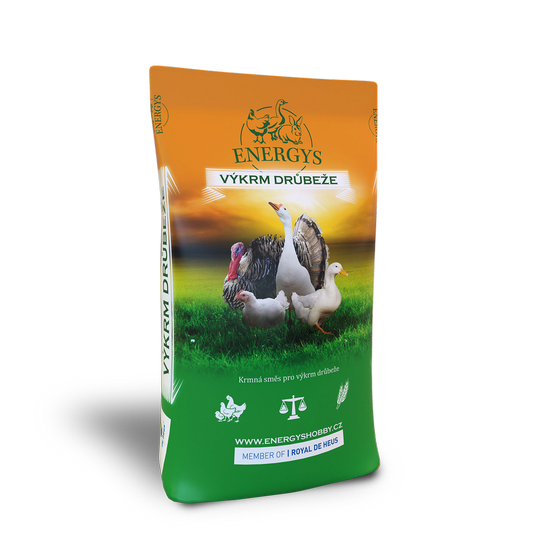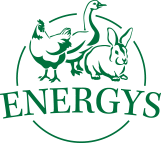Rabbits
Poultry
Laying hens
Quails
Guinea pigs
Pigs
Ostriches
Sheep and goats
Pigeons
Pheasants
Forest animals
Fattening of ducks and geese – water poultry
When feeding and fattening ducks and geese, it is important to be aware of the differences between the main nutritional requirements. Experienced breeders are familiar at least with the basic differences between geese, ducks and Muscovy ducks.
Goose (individual original breeds or farmed hybrids) is an exclusive herbivore. Adding green fodder is suitable in the case of conventional breeding. Geese thrive on limited green grazing. Limiting movement and feeding exclusively grain fodder is suitable in the final stage of fattening (feeding mixture for the final stage of fattening).
Duck (mostly based on the Beijing duck breed) is an omnivore. Feeding doses comprising feeding mixtures may be supplemented with slaughterhouse waste or feeding blood with a smaller proportion of green fodder.
Muscovy duck is capable of feeding on green fodder from the enclosure in addition to feeding mixtures. If you want feeding to be intensive, it is good to limit the area and follow the animal’s behaviour. Ducks kept in an excessively small area tend to peck each other’s feathers growing on their wings and gradually all over their bodies. This duck needs a lot of protein during the intensive growth stage. Meat waste products may be given to these ducks as a supplement. Feeding the special type of the Muscovy duck called “barbarie” for very intensive breeding and a high proportion of meat is very complicated (especially for protein content).
During the initial stage of feeding (the first several weeks), using complete feeding mixture is suitable for triggering growth and for preventing high mortality. Partial use of the “cheaper local” sources of nutrients is appropriate during the fattening stage to increase the effectiveness of feeding.
Finally, several terms for clarity:
Barbarie: a term used for Muscovy ducks bred for meat, which were bread in France by selection and crossbreeding of different lines of Muscovy ducks. However, it is still a type of the Muscovy duck.
Duck-goose: a common term for the Muscovy duck. The term “Muscovy duck” would not look great on a blackboard in a butcher’s shop or a different shop. Ducks costing twice as much as the traditional Czech “fatty” goose would not sell very well either. This is why the term “duck-goose” was coined to improve the sales of the Muscovy ducks. Many consider the meat from these ducks to be one of the tastiest poultry products.
Mallard: usually a crossbreed between a male Muscovy duck (these are always very active) and a duck (Beijing duck – these production lines are good layers). The mallard grows very well and has similar feeding needs to the duck. It is excellent for fattening and does not reproduce.
Related posts
5. December 2025
In small-scale farming, it is common to encounter situations where breeders offer animals a smaller amount of complete feed mixture than recommended by the manufacturer, and replace the rest of the feed ration with grains such as wheat, barley, or corn. Grains certainly have their value in feeding, but on their own, they are not…
16. March 2022
When selecting feed (not only) for poultry, it is essential to base it on the purpose of the breeding or fattening phase. Energys hobby feeds accentuate these needs, so you are sure to choose whatever stage of development your poultry is in. But how do you choose the right feed and which is the most…
16. March 2022
When selecting feed (not only) for poultry, it is essential to base it on the purpose of the breeding or fattening phase. Energys hobby feeds accentuate these needs, so you are sure to choose whatever stage of development your poultry is in. But how do you choose the right feed and which is the most…
9. December 2021
While there are technological procedures for the rearing and fattening of common species and utility types of poultry, there are only few instructions for the so-called non-traditional poultry species, but also for runners with potential for commercial use. In this article you will find basic information on the breeding of Barbary and Mallard ducks.
22. February 2021
Spring is the period when chickens start to be fattened in domestic conditions. For the purposes of meat production, it is best to use specially-bred hybrid meat breeds that have the genetic properties of fast growth and high muscle mass. These breeds are called broiler chickens or broilers.
Related products

POULTRY UNI 30
A mashed concentrate for fattening of all categories of poultry, which includes the highest quality soja. It is mixed with cereals in a ratio of 20-40% (by type or phase of fattening). It contributes to fast growth and a high meat content. It does not contain coccidiostats.

BROILER MAXI
Feed for the final phase of fattening broilers. Supports a high meat content and a delicate meat taste. Start using it 5 or more days before slaughter. Does not contain coccidiostatics.

BROILER MIDI FORTE
A granulated feed mix for the intensive fattening of broilers from 15 days of age to a minimum of 5 days before ending feeding up. The Coccidiostat included lowers mortality during fattening. For the next phase of fattening Broiler MAXI is a suitable mix.

BROILER MINI FORTE
A ground feed mix with Coccidosistats, for the intensive feeding of broiler chickens up to 14 days of age and a support to fast growth a an excellent state of health in your broliers-

DUCK MINI
A high quality ground mix for fattening ducks and geese up to their 2nd week. It is suitable for fast growth and high meat content.

TURKEY MAXI
Feed for the final stage of turkey fattening. Use from the 13th week of age. It does not contain a coccidiostat.

TURKEY MIDI FORTE
A high quality granulated feed with coccidiostats for feeding turkeys from 5 to 12 weeks of age. It is the basis for fast growth, high meat content and an excellent state of health of your turkeys. The coccidiostat content lowers mortality during feeding. It continues on from feeding with Turkey Mini Forte. The live weight for turkeys at the end of this period should be around 5.9 kg for hen turkeys and 8.9 kg for cocks.

TURKEY MINI FORTE
A ground mix with Coccidiostats for fattening turkeys up to an age of 4 weeks. It is the basis for high meat content. Afterwards use the Turkey Midi Forte mix.

DUCK MAXI
A granulated mix for feeding ducks and geese from 3 weeks of age up to slaughter. The nutrients it contains support fast growth , a high meat content and a delicate meat taste.
